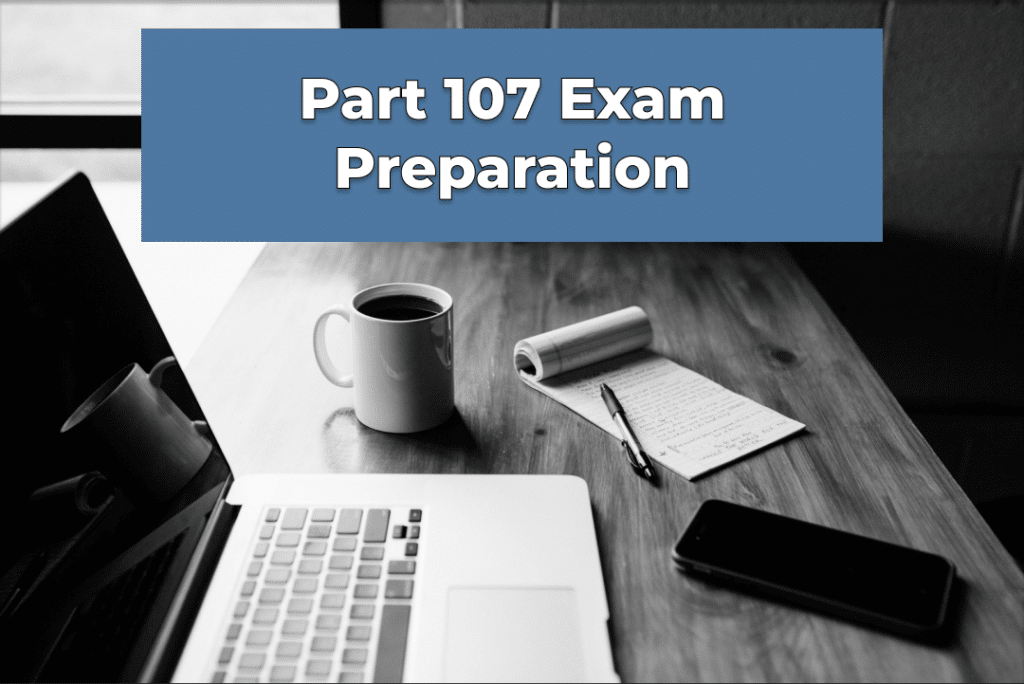Part 107 Exam for
Commercial Drone Pilots
What is the Part 107 Exam?
The Federal Aviation Administration’s Small UAS Rule (Part 107) is a requirement for all commercial drone pilot’s within the United States. All commercial drone pilots within the United States must hold a Remote Pilot Certification issued by the Federal Aviation Administration (FAA) after passing the Part 107 Exam. The FAA’s website provides a detailed overview of additional requirements for commercial drone pilots.
The following resources have been created to help you prepare for the Part 107 Exam so you can pass the exam on your first try.

Recreational vs. Commercial Drone Pilots
It’s important to first understand the FAA’s requirements based on your interests as a drone pilot. If you plan on only flying your drone recreationally – for fun or personal enjoyment – you do not need to obtain a Remote Pilot Certification.
Recreational Drone Pilots
While hobbyists and recreational drone pilots do not need to take the Part 107 Exam, they do need to take The Recreational UAS Safety Test (TRUST), also offered by the FAA. The TRUST provides education on important safety and drone flying regulations that all pilots must abide by.
Additional requirements for recreational drone pilots are as follows:
- Weight Limit: Your drone must weigh under 55 lbs. (note that certain community-based organizations may provide exemptions)
- Registration: Your drone must be registered on the FAADroneZone website. This is the FAA’s official website for managing drones for recreation, education, government, and business. You can access waiver and airspace authorization applications, get recognized as a community-based organization, submit an accident report, and more.
- Line of Sight: When flying your drone, it must remain in visual line-of-sight at all times.
- Restricted Airspace: you must abide by the FAA’s regulations and not fly in restricted airspace. The UAS Facility Maps provides useful information, along with DJI’s GEO Zone Map
- Community-Based Organization (CBO) Guidelines: You must follow certain guidelines outlined by community-based organizations. More CBO information can be found on the FAA Recreational Flyers & Modeler page

Commercial Drone Pilots
Non-recreational drone flights – or commercial flight – includes photo taking, property inspections, roof inspections, and/or any drone activity that is done for monetary value or indirect compensation, such as goodwill. For example, volunteering to fly your drone for a non-profit forestry service is considered “commercial” and not recreational.
The FAA outlines commercial drone operator regulations on the Part 107 Small Unmanned Aircraft Rule page. A few key commercial drone operator requirements to be aware of include:
- Remote Pilot Certificate: to become an FAA-Certified Drone Pilot, you must pass the knowledge test (Part 107 Exam).
- Weight Limit: Your drone must weigh under 55 lbs. (note that certain community-based organizations may provide exemptions).
- Registration: Your drone must be registered on the FAADroneZone website. This is the FAA’s official website for managing drones for recreation, education, government, and business. You can access waiver and airspace authorization applications, get recognized as a community-based organization, submit an accident report, and more.
- Airspace Flight: You are only permitted to fly in Glass G airspace. Reference the FAA’s Rules of the Sky page to learn more about airspace. You must also fly below 400 feet and less than 100 mph.
- Line of Sight: When flying your drone, it must remain in visual line-of-sight at all times.
- Night Flying: anti-collision lighting must be used while flying at night (includes dawn or dusk).
Additional commercial drone operator rules can be found on the FAA website.
Preparing for the Part 107 Knowledge Test
Preparing for the Part 107 Small UAS Rule exam
Once you’ve decided to become a commercial drone pilot, there are several requirements and steps of preparation you must take prior to taking the Part 107 Knowledge test.
- FAA Tracking Number (FTN): create an Integrated Airman Certification and Rating Application (IACRA). This will guide users through the process of creating an FAA’s airman application.
- Qualifications: FAA-Certified Drone Pilots must be at least 16 years old, able to read/speak/write English, and be in physical/mental condition to fly safely.
- Study Guides: The FAA offers a library of study material for drone pilots to help with exam preparation. Use these resources to prepare for the Part 107 Exam.
Part 107 Exam Topics:
- Applicable regulations relating to small unmanned aircraft system rating privileges, limitations, and flight operation
- Airspace classification and operating requirements, and flight restrictions affecting small unmanned aircraft operation
- Aviation weather sources and effects of weather on small unmanned aircraft performance
- Small unmanned aircraft loading and performance
- Emergency procedures
- Crew resource management
- Radio communication procedures
- Determining the performance of small unmanned aircraft
- Physiological effects of drugs and alcohol
- Aeronautical decision-making and judgment
- Airport operations
- Maintenance and preflight inspection procedures
- Operation at night
Taking and Passing the Part 107 Exam
The Part 107 Exam must be taken at an approved knowledge testing center. You can schedule a test appointment on the PSI True Talent website. You can also access practice exams, find testing centers, research additional FAQs, and contact the PSI FAA directly.
Once you’ve passed the test, return to the Integrated Airman Certification and Rating Application website and login to complete the promoted steps outlined on the FAA website.
